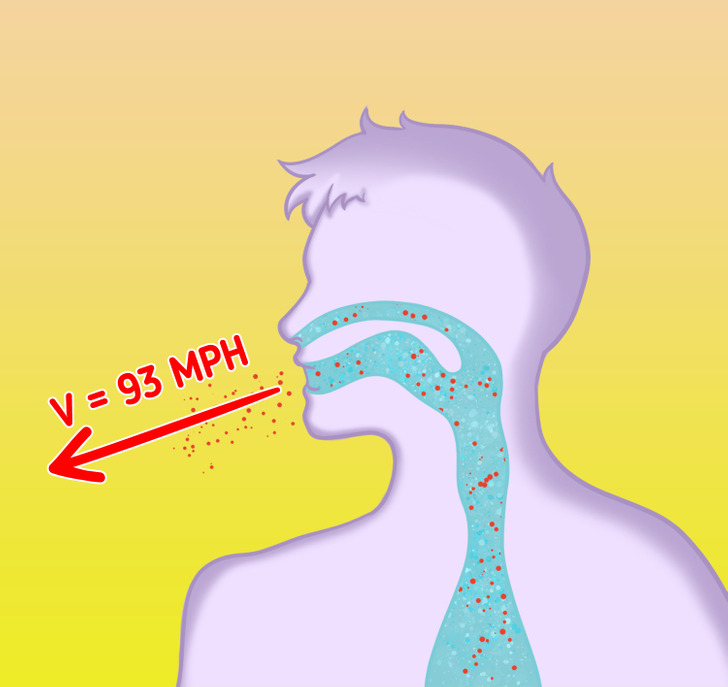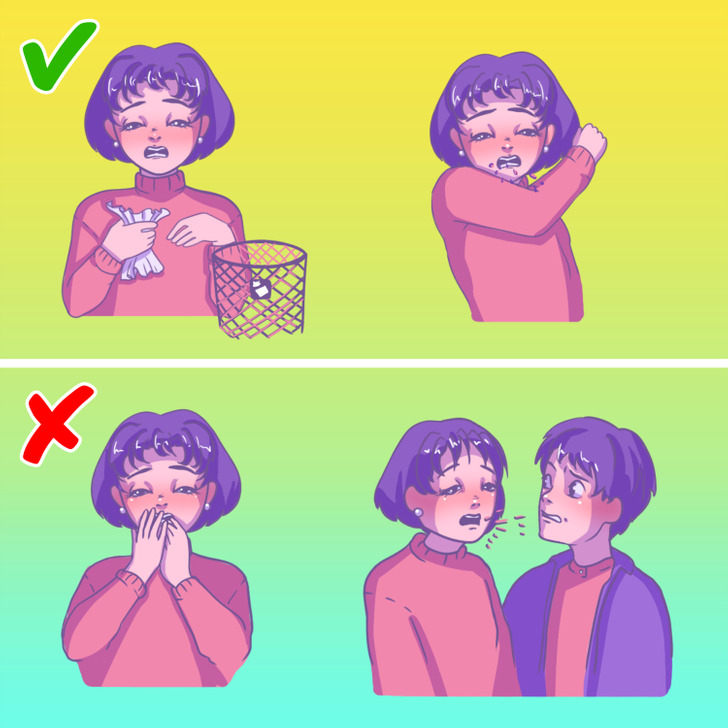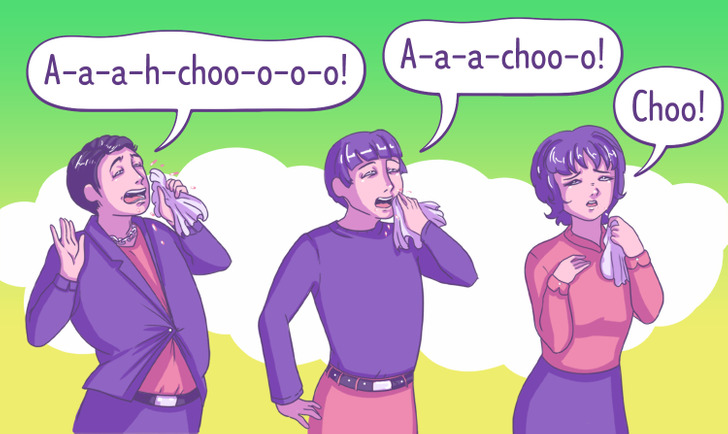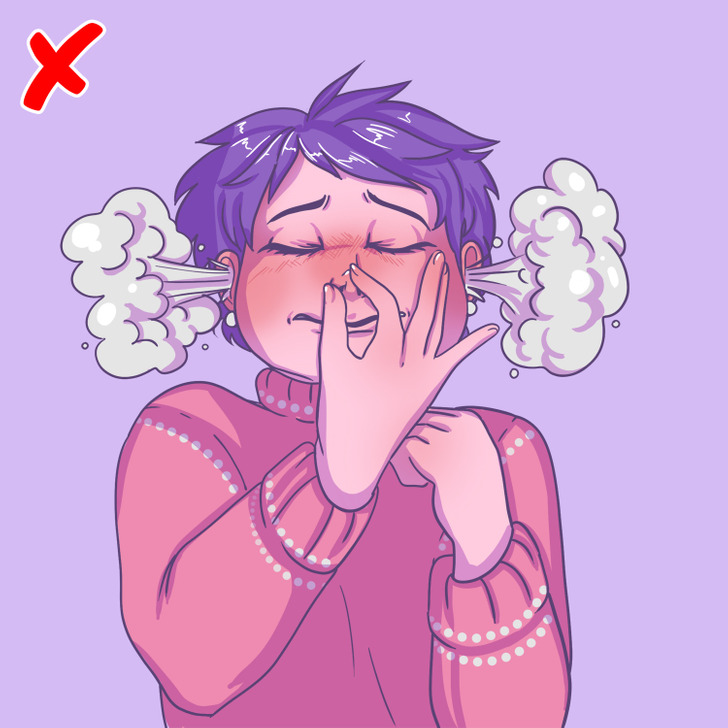How to Sneeze Correctly
All people sneeze, it’s nothing surprising. Sneezing is a natural physiological process, but still, some rules apply here too, and we should stick to them to protect ourselves and those around us from distributing bacteria and viruses.
5-Minute Crafts is telling you how to sneeze correctly and not cause any harm.
“Why do I really need to learn to sneeze correctly?” you might ask. The answer is simple: by doing it incorrectly, you not only risk infecting others but also seriously harming your body.
Why we sneeze

Sneezing is an involuntary bodily response to help remove irritants in the nose and throat. The airstream tries to push allergens, dust, and infection out of the nasopharynx. Most often, it’s people with allergies and colds that sneeze. You can also sneeze from bright light or a breath of frosty air. Many sneeze from dust, soda bubbles, and other irritants to the nasopharynx.
The process of sneezing starts with the irritation of the nasal mucosa. After this, the receptors signal the brain to clear the nasopharynx using the trigeminal nerve. Before you sneeze, you feel a buildup of pressure in your chest. It is the muscles that compress the lungs while the vocal cords close. Then they open again, air rises through the respiratory tract, and it exits through the nose at a speed of about 150 km per hour (93 mph), throwing thousands of drops of mucus out of the nasopharynx. This is how our body gets rid of unwanted particles. But we should remember that they are capable of spreading disease.
How to sneeze correctly

- Do it into a tissue. The ideal option is to sneeze into a tissue or handkerchief. It’s best if they are disposable. After you sneeze, they should be thrown away into a garbage bin.
- Sneeze in the bend of your elbow or sleeve. If you don’t have a tissue ready, don’t sneeze into the air. It’s better to sneeze into the bend of your elbow or sleeve.
- Sneeze after you’ve turned away. When possible, try to turn away from people at the moment of sneezing. It will help protect them because the mucus we make can contain viruses.
- Clean or disinfect your hands. After sneezing, wash your hands with soap or disinfect them.
It’s important! Don’t sneeze into your hand. If you do, try not to touch any surfaces until you wash your hands.
Why all people sneeze differently

You’ve probably noticed that each person has their own style of sneezing. Some people sneeze loudly, others at medium loudness, and some, almost silently. Oftentimes, this happens because each of us has our own reactions to irritants and allergens. In addition, their numbers play a role too.
People produce different sounds when sneezing because of their differences in the anatomy of the nose and in the strength of respiratory muscles. The strength of a sneeze depends on the amount of air that you breathed in before. In addition, the volume of your lungs plays a role here too. The more this volume is and the more air you breathe in, the stronger the sneeze will be because the body needs to release a lot of air.
Why we sneeze several times in a row
Perhaps each of us has sneezed 2 or more times in a row. Usually, this happens when the irritant doesn’t disappear within one sneeze. Receptors feel its presence, send a signal to the brain, and the whole process starts over. Therefore, we can sneeze several times in a row.
It’s absolutely normal to sneeze this way. However, if sneezing bothers you or brings some kind of discomfort, you’d better consult with a doctor.
If it’s okay to hold back a sneeze

We’ve already mentioned that during sneezing, air flies out at a tremendous speed. Holding back this process can lead to a rupture of the eardrum and pharynx.
If a person is ill, their body gets rid of viruses or bacteria that the mucus contains while sneezing. And if this person holds back the sneezes, the mucus can accumulate and get back into the eustachian tubes. The eustachian tubes are small passageways that join the throat with the middle ear. They open when we swallow, yawn, or sneeze so air pressure or fluid won’t accumulate in our ears.
The return of the infected mucus back into the eustachian tubes can start an infection of the middle ear.
The longest sneezing fit
It’s hard to believe, but it’s possible to sneeze for years. A British woman named Donna Griffiths started to sneeze on January 13, 1981 and finished only on September 16, 1983. Because of this, she made it into the Guinness World Records.
It has been estimated that Griffiths sneezed about 1 million times during the first year.
How to make yourself sneeze

Sometimes a person wants to sneeze, but suddenly everything stops. So the person ends up with the urge to sneeze but nothing happens. We’ve collected several tips that can help you sneeze.
- Look at a bright light. It is reported that about 1/4 of all people sneeze when looking at bright light. You just need to look at it quickly.
- Tickle the nose. Take a corner of tissue and carefully tickle the inside of your nose with it.
- Tweeze your eyebrows. Girls have likely noticed that they sneeze when tweezing their eyebrows.
- Pull your nose hair. Grab some tweezers and carefully pull a couple of hair out of your nose. This method is not very pleasant but it does work.
- Sniff some soda. Bring a soda drink close to your nose. The popping air bubbles will act as an irritant, and you will sneeze.